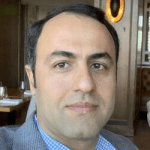Quantum News Briefs October 7: Airbus Ventures leads Qunnect’s $8 million series A financing round for launch of quantum network testbed in NYC; Intel hits key milestone in quantum chip production research; Towards Programmable Optical Quantum Memory & MORE

Quantum News Briefs October 7 opens with Airbus Ventures leads Qunnect’s $8 million series A financing round to advance the launch of its quantum network testbed in New York City followed by Intel’s announcement it hit key milestone in quantum chip production research. Third is Paderborn University’s work “Towards programmable optical quantum memory and MORE.
Airbus Ventures leads Qunnect’s $8 million series A financing round for launch of quantum network testbed in NYC
 Masha Abarinova writes in Fierce Electronics of Qunnect’s series $8 million n Series A financing to advance the launch of its quantum network testbed in New York City. Quantum News Briefs summarizes below.
Masha Abarinova writes in Fierce Electronics of Qunnect’s series $8 million n Series A financing to advance the launch of its quantum network testbed in New York City. Quantum News Briefs summarizes below.
The round was led by Airbus Ventures, with additional participation from Quantonation, SandboxAQ, NY Ventures, Impact Science Ventures, and Motus Ventures. Spearheaded by CEO Dr. Noel Goddard and founders Dr. Mehdi Namazi and Mael Flament, Qunnect is developing quantum-secure networking technology designed for scalable deployment on existing telecom fiber infrastructure. These new funds will be used to further develop their product suite, scale manufacturing, and launch a multi-node R&D quantum network testbed to demonstrate entanglement distribution protocols. This network, connected to existing fiber optic cable in New York City, will be the first of its kind in the US.
QKD is a secure communication method that works by transmitting photons between locations. The photons are generated into bit sequences, which can be used as data encryption keys.
“The establishment of a state-of-the-art testbed in the U.S. will open the door for customers in financial services, critical infrastructure and telecom to test our technologies in the New York metropolitan area,” said Noel Goddard, CEO of Qunnect, in a statement.
“At Airbus Ventures, we are particularly interested in investing in enabling technologies that make quantum practically usable, out of the lab environment and into the real world, where these portfolio companies can aid in tangibly addressing major security challenges being faced today,” notes Airbus Ventures Partner Nicole Conner in the Businesswire news release. The majority of quantum networking technologies seen in the research community require extreme cooling and/or high vacuum support infrastructure. In contrast, Qunnect’s first-in-class solutions support real-world deployment and scalability, designed to be operational at room temperature – rather than fragile, climate-controlled laboratory settings.
“We have spent the last several years tailoring every one of our quantum devices to meet the requirements of large-scale, telecom-integrated quantum networking. Now that we have the team and the support, with special thanks to the Airbus Ventures team, we are now ready to start our next phase with a concentrated focus on scalability and field-deployment,” remarks Dr. Mehdi Namazi, Qunnect Co-Founder and CSO.
The multi-node network, connected to the city’s existing fiber optic cable, will be used to test entanglement distribution protocols – a key element of quantum computing. Click here for original article.
*****
Intel hits key milestone in quantum chip production research
 The Intel Labs and Components Research organizations have demonstrated the industry’s highest reported yield and uniformity to date of silicon spin qubit devices developed at Intel’s transistor research and development facility, Gordon Moore Park at Ronler Acres in Hillsboro, Oregon. Quantum News Briefs summarizes below the announcement from Intel’s Newsroom.
The Intel Labs and Components Research organizations have demonstrated the industry’s highest reported yield and uniformity to date of silicon spin qubit devices developed at Intel’s transistor research and development facility, Gordon Moore Park at Ronler Acres in Hillsboro, Oregon. Quantum News Briefs summarizes below the announcement from Intel’s Newsroom.
This achievement represents a major milestone for scaling and working toward fabricating quantum chips on Intel’s transistor manufacturing processes.
The research was conducted using Intel’s second-generation silicon spin test chip. Through testing the devices using the Intel cryoprober, a quantum dot testing device that operates at cryogenic temperatures (1.7 Kelvin or -271.45 degrees Celsius), the team isolated 12 quantum dots and four sensors. This result represents the industry’s largest silicon electron spin device with a single electron in each location across an entire 300 millimeter silicon wafer.
Today’s silicon spin qubits are typically presented on one device, whereas Intel’s research demonstrates success across an entire wafer. Fabricated using extreme ultraviolet (EUV) lithography, the chips show remarkable uniformity, with a 95% yield rate across the wafer. The use of the cryoprober together with robust software automation enabled more than 900 single quantum dots and more than 400 double dots at the last electron, which can be characterized at one degree above absolute zero in less than 24 hours.
“Intel continues to make progress toward manufacturing silicon spin qubits using its own transistor manufacturing technology,” said James Clarke, director of Quantum Hardware at Intel. “The high yield and uniformity achieved show that fabricating quantum chips on Intel’s established transistor process nodes is the sound strategy and is a strong indicator for success as the technologies mature for commercialization.”
“In the future, we will continue to improve the quality of these devices and develop larger scale systems, with these steps serving as building blocks to help us advance quickly,” Clarke said.
*****
Towards Programmable Optical Quantum Memory
 Researchers from Paderborn University have been working with colleagues from Ulm University to develop the first programmable optical quantum memory. The study was published as an ‘editor’s suggestion’ in the Physical Review Letters journal.
Researchers from Paderborn University have been working with colleagues from Ulm University to develop the first programmable optical quantum memory. The study was published as an ‘editor’s suggestion’ in the Physical Review Letters journal.
The ‘Integrated Quantum Optics’ group led by Prof. Christine Silberhorn from the Department of Physics and Institute for Photonic Quantum Systems (PhoQS) at Paderborn University is using minuscule light particles, or photons, as quantum systems. The researchers are seeking to entangle as many as possible in large states. Working together with researchers from the Institute of Theoretical Physics at Ulm University, they have now presented a new approach.
Previously, attempts to entangle more than two particles only resulted in very inefficient entanglement generation. If researchers wanted to link two particles with others, in some cases this involved a long wait, as the interconnections that promote(?) this entanglement only operate with limited probability rather than at the touch of a button. This meant that the photons were no longer a part of the experiment once the next suitable particle arrived – as storing qubit states represents a major experimental challenge.
The quantum physicist explains: ‘Our system allows entangled states of increasing size to be gradually built up – which is much more reliable, faster, and more efficient than any previous method. For us, this represents a milestone that puts us in striking distance of practical applications of large, entangled states for useful quantum technologies.’ The new approach can be combined with all common photon-pair sources, meaning that other scientists will also be able to use the method.
*****
University of Illinois researchers close a gap in the quantum cloning machine literature

Electrical and Computer Engineering graduate student Haneul Kim and ECE associate professor Eric Chitambar of the University of Illinois have published in Physical Review their new result on a well-established theoretical construct called a quantum cloning machine using semidefinite programming, a mathematical methodology that studies how to efficiently optimize complicated processes. Quantum News Briefs summarizes below.
On the surface, quantum cloning machines pose a threat to communications protocols based on the famous no-cloning theorem of quantum mechanics, which states that no quantum mechanical operation can create an exact duplicate of a quantum state. Instead of trying to produce exact copies of quantum states, they try to create approximate replicas close enough to fool the communicating parties. Such processes are constructed using the methods of semidefinite programming: the unattainable cloning operation is approximated by an imperfect, but realizable process. However, early research efforts established strong, fundamental limits rendering these processes practically ineffective.
In their article “Process-optimized phase-covariant quantum cloning,” Kim and Chitambar note that there is a missing detail in the discussion of cloning machines specialized to so-called phase covariant states (a type of quantum state easy to characterize and manipulate) that contain multiple levels. The standard quantum information processing unit is the two-level qubit, which is widely used for its theoretical simplicity and comparative ease of realization. However, multi-level processing units (called “qudits”) are theorized to offer more power and robustness, so it is desirable to know if these features come at the cost of security.
In the absence of a result, the researchers went ahead and found one. After using methods from semidefinite programming to construct an optimal cloning machine tuned to phase covariant states, they demonstrated that the process-optimized fidelity, a measure of the quality of replicated states, decreases as the number of levels in the processing unit increases. This result is consistent with those for more general cloning machines, confirming they will not pose a serious threat even if multi-level processing units are adopted. Click here for original news announcement.
****
Sandra K. Helsel, Ph.D. has been researching and reporting on frontier technologies since 1990. She has her Ph.D. from the University of Arizona.

























